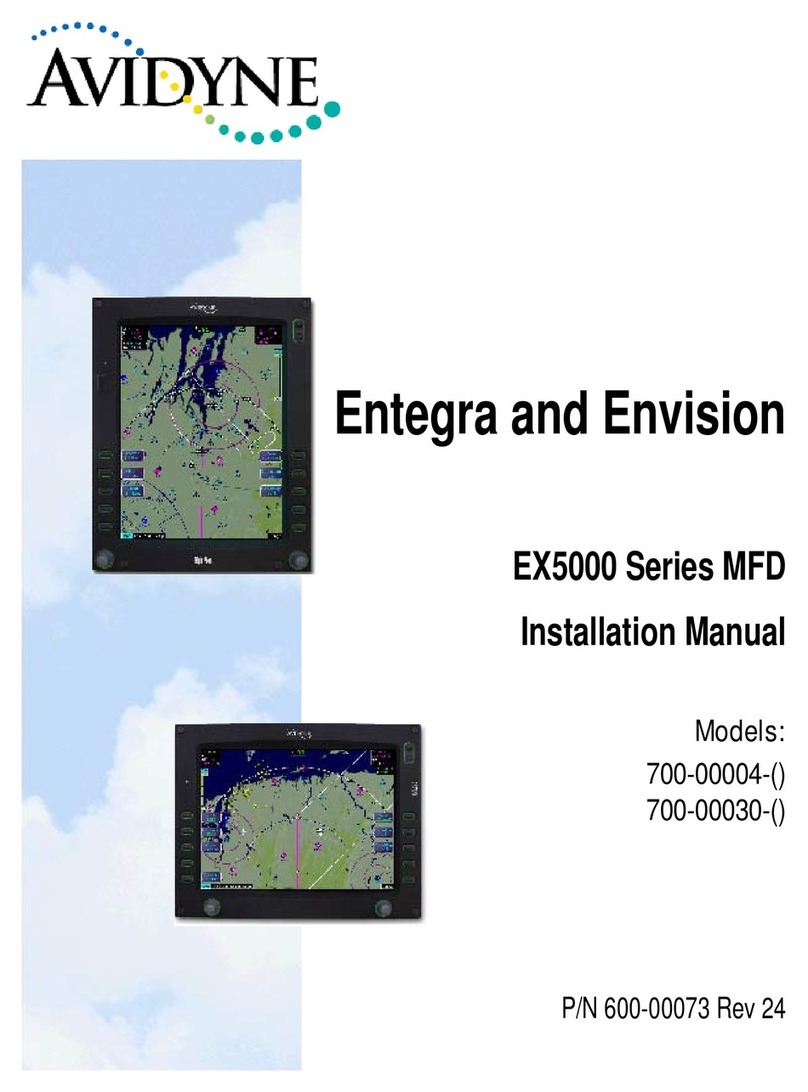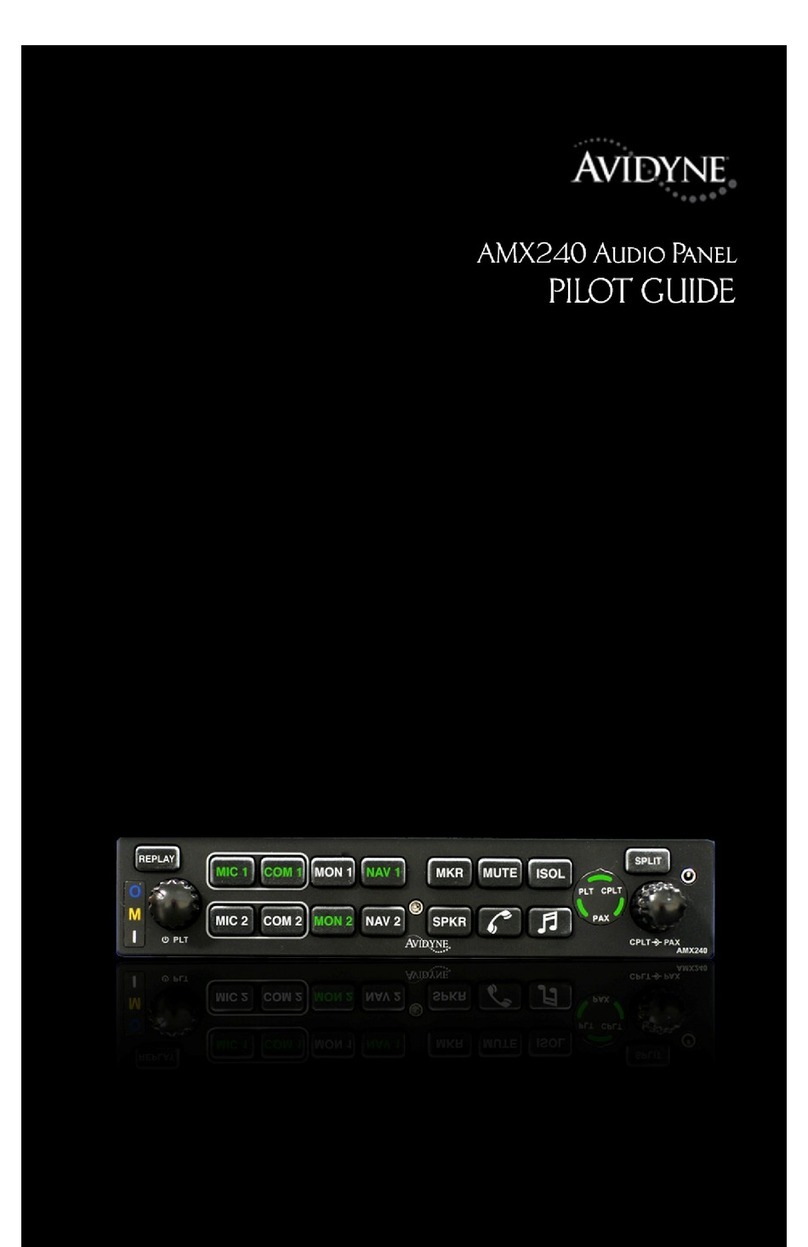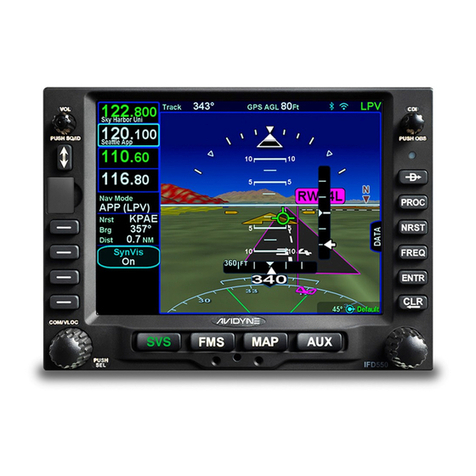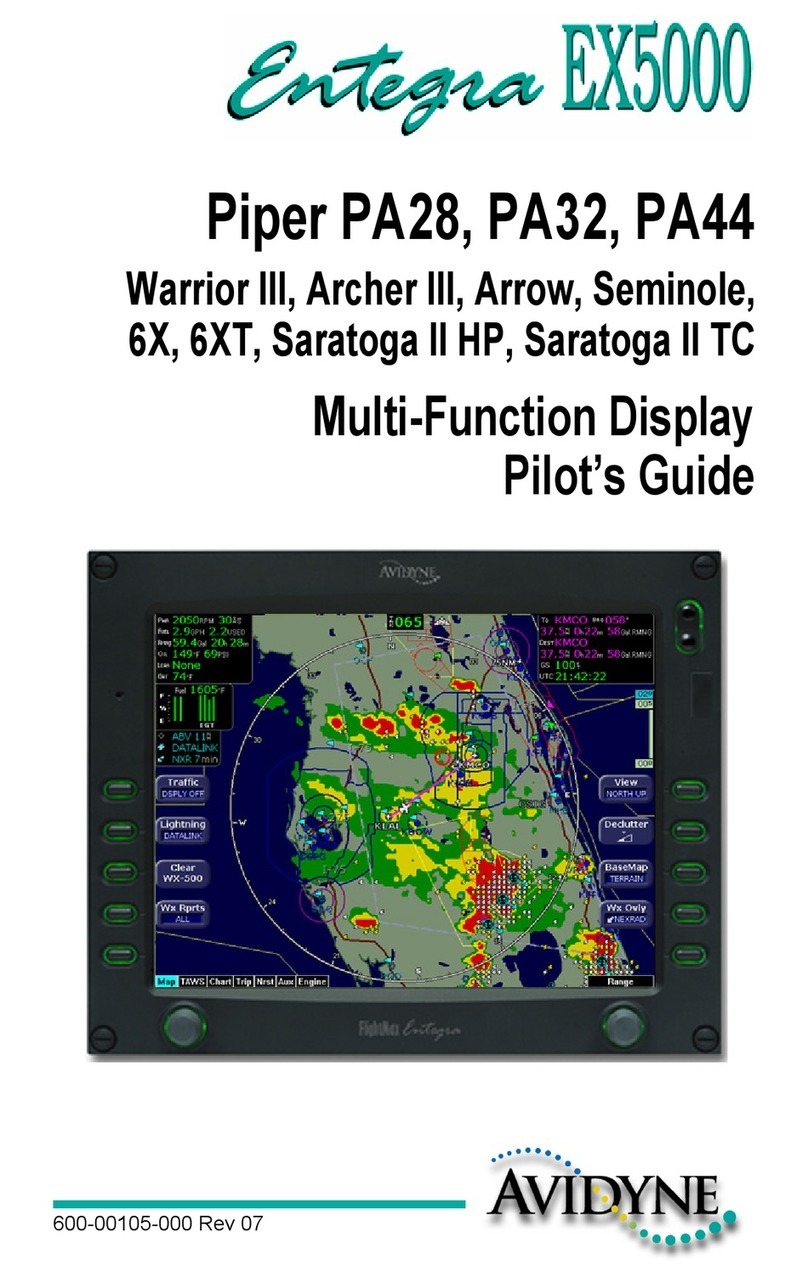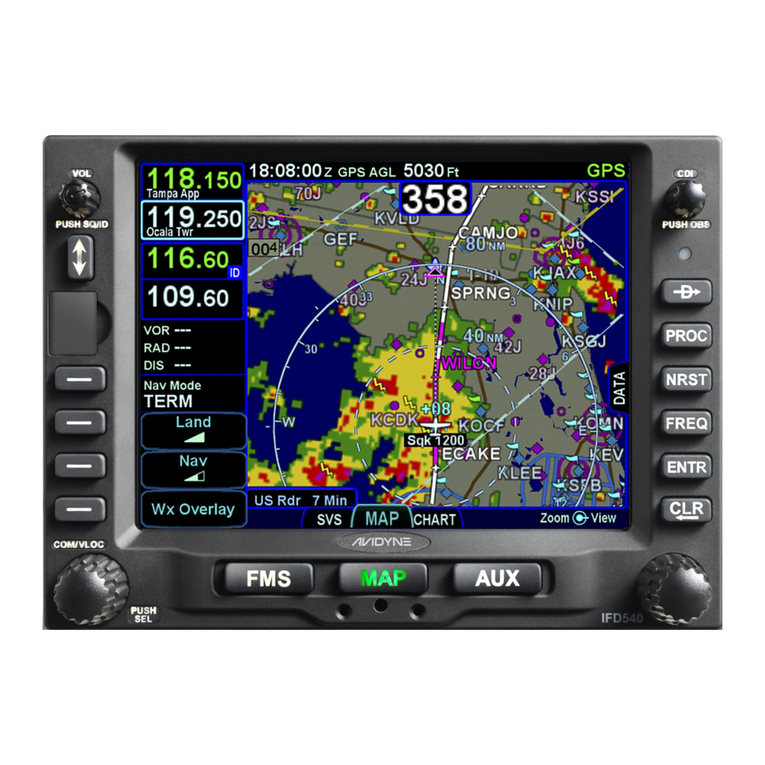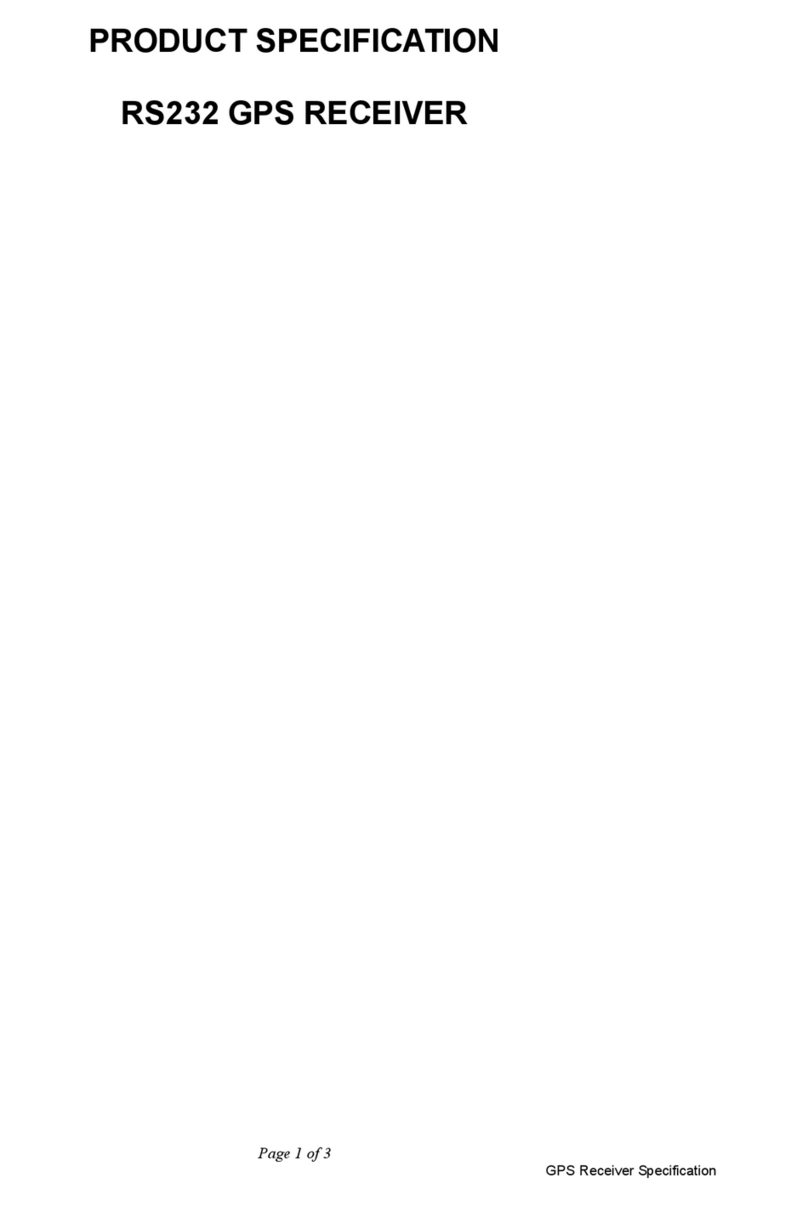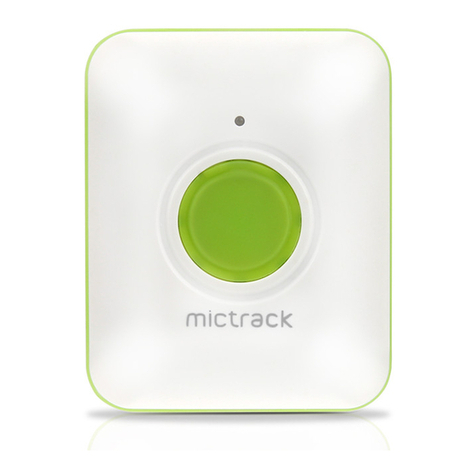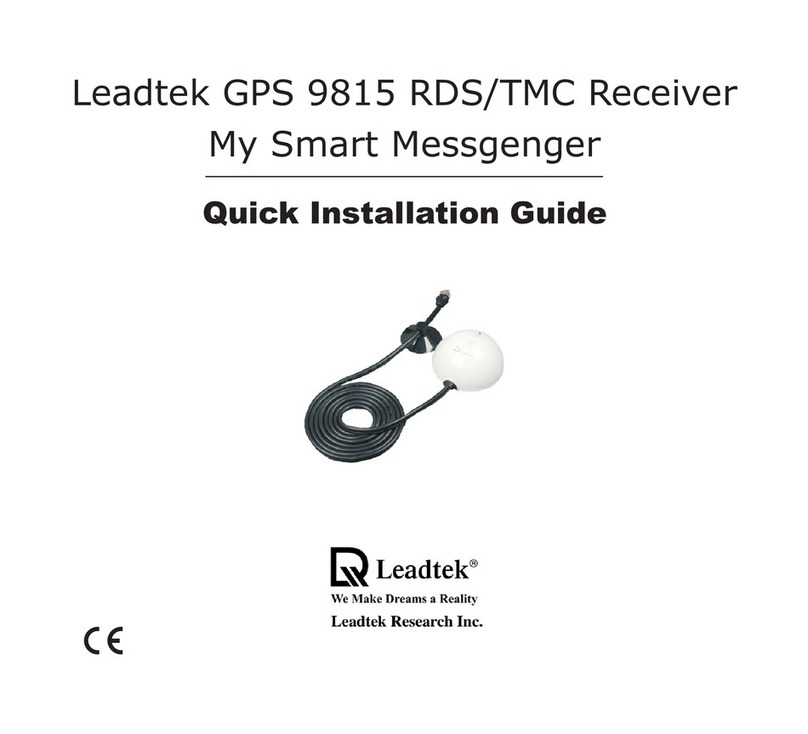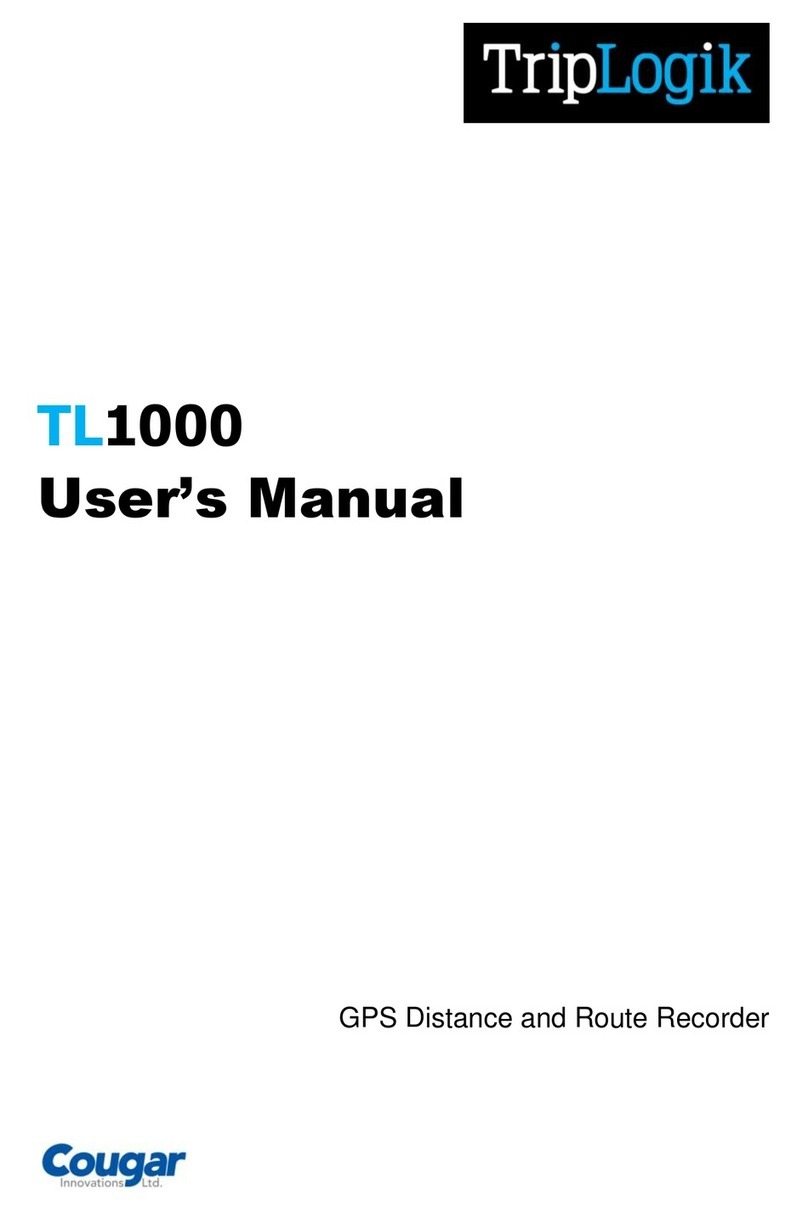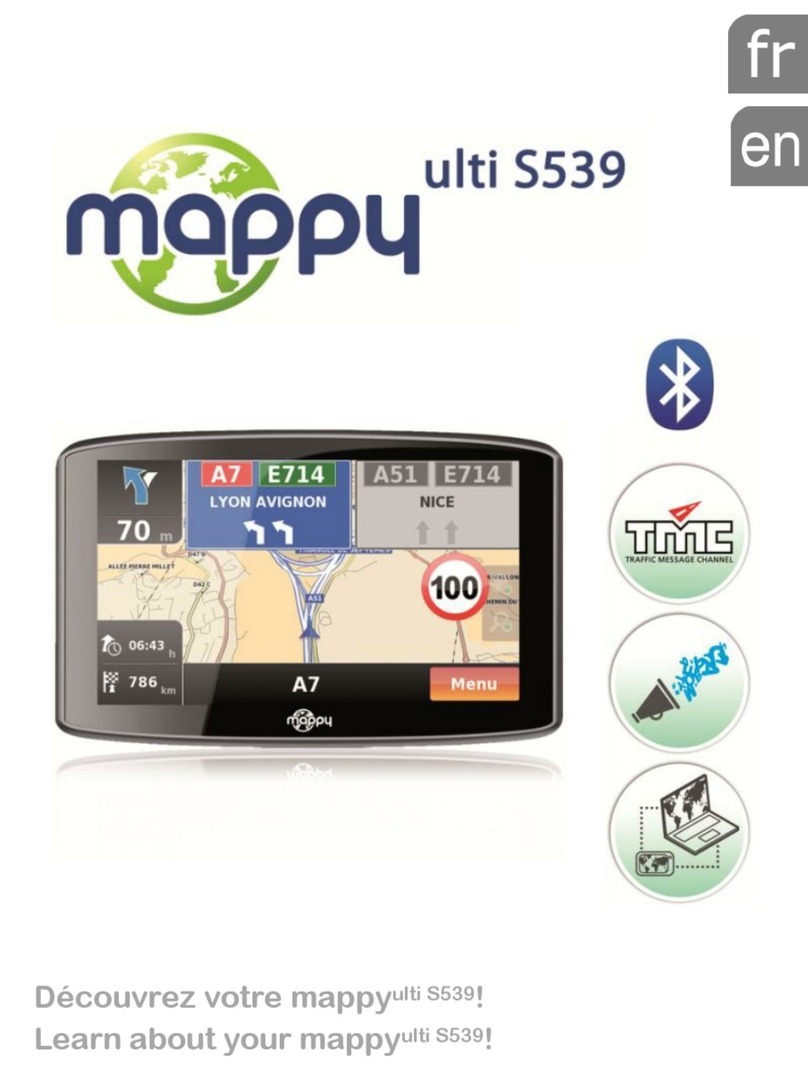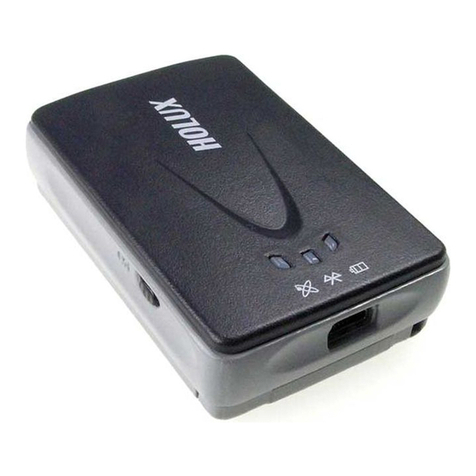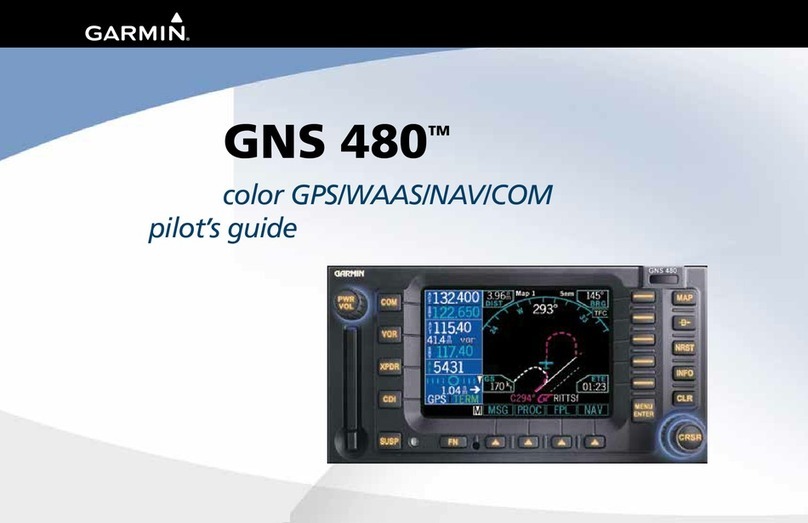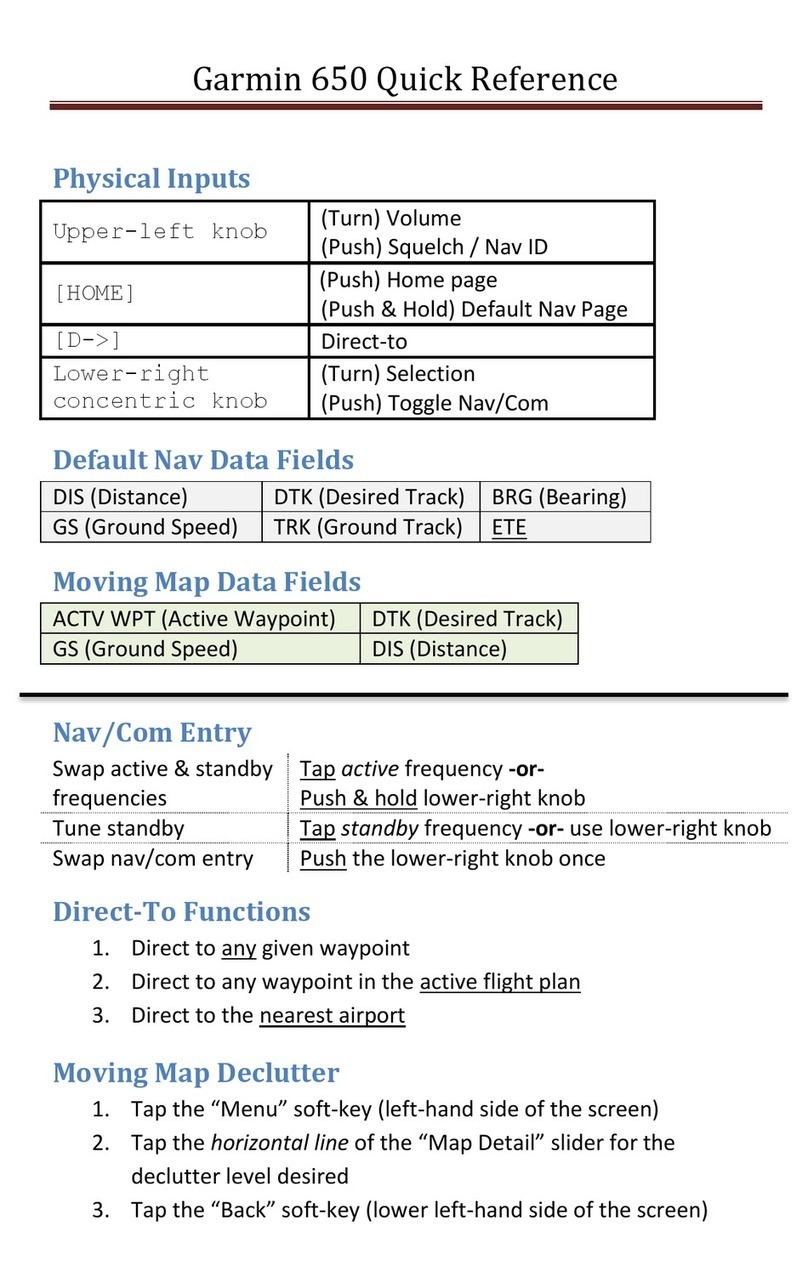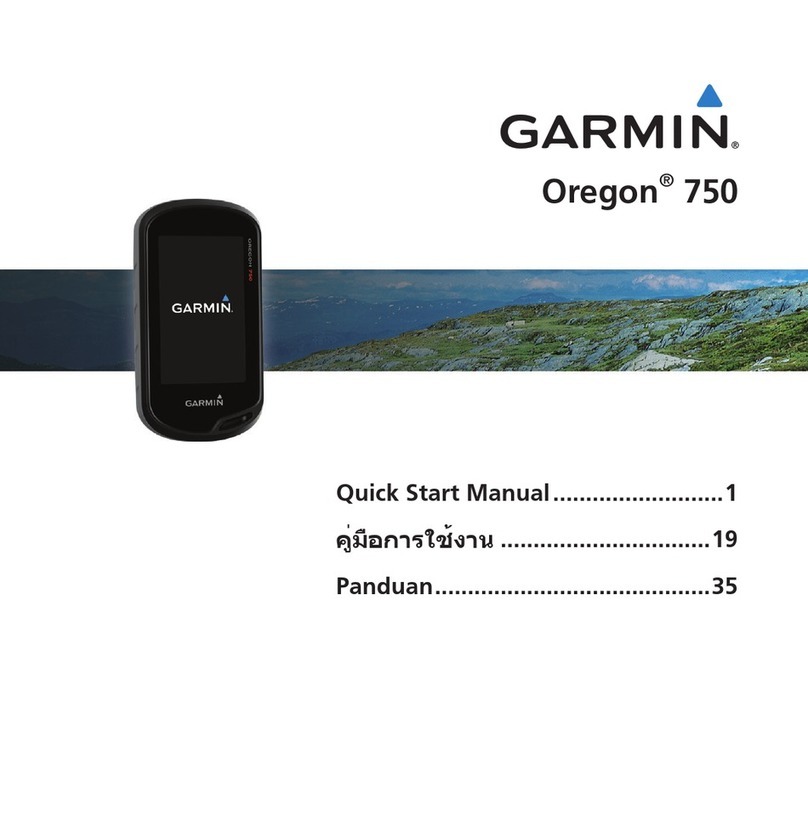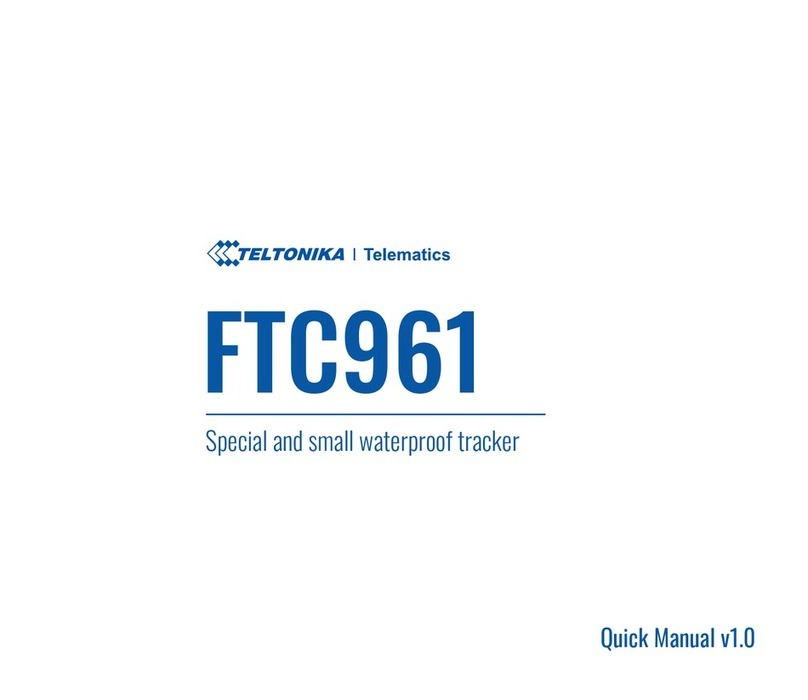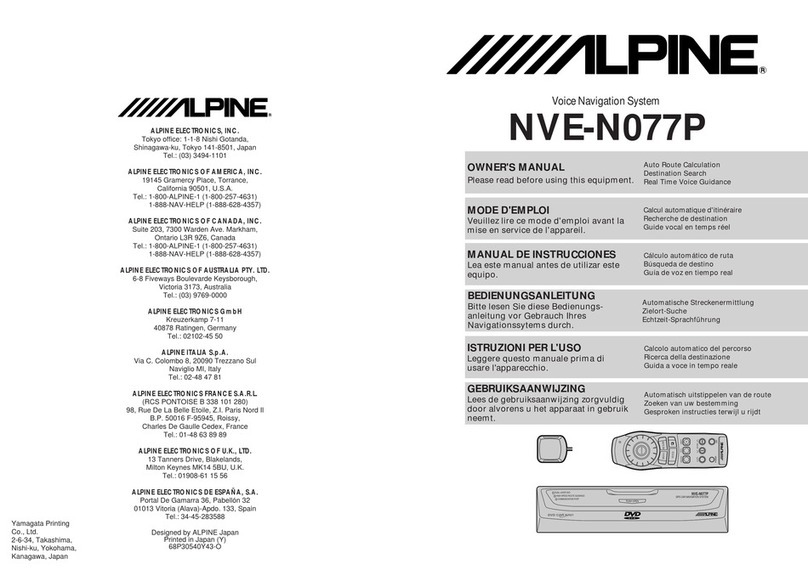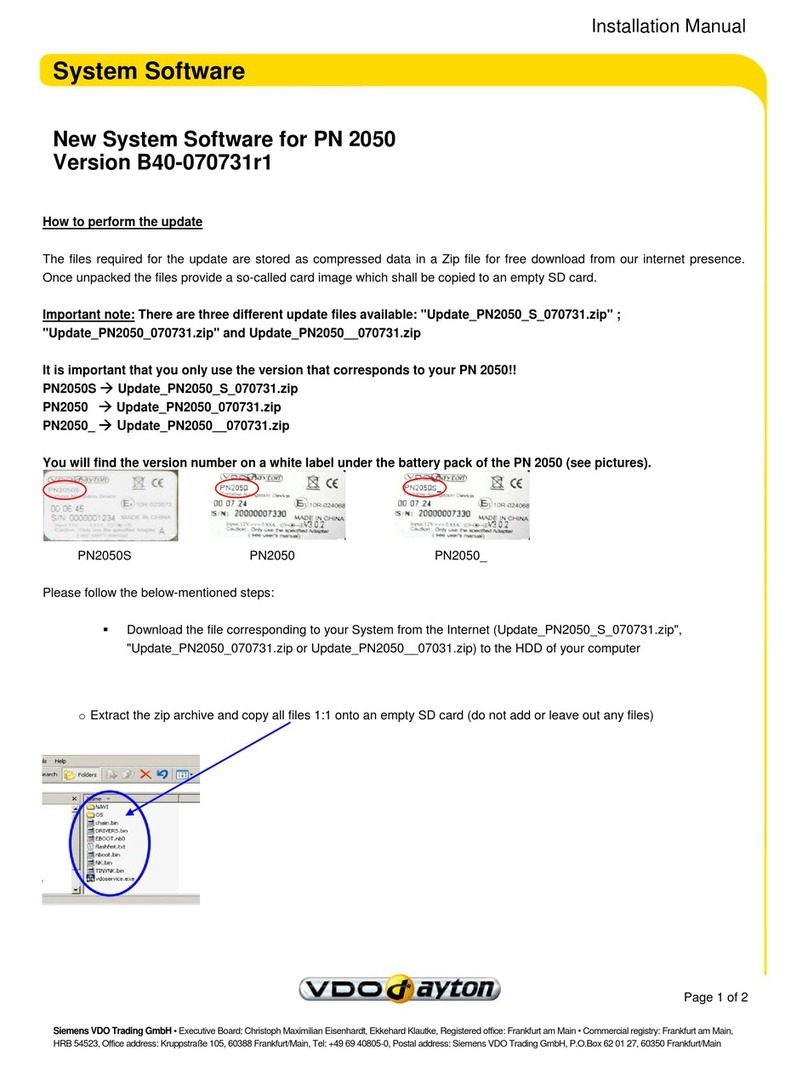Avidyne SkyTrax 200 Manual

SkyTrax ADS-B Receiver
Pilot’s Guide

Revision History
Revision
Date of Release Reason for Release
00
April 2019
Initial Release
01
February 2021
Add SkyTrax 200


SkyTrax Pilot Guide
1 Table of Contents
TABLE OF CONTENTS
1System Overview ...............................................................1-3
EQUIPMENT DESCRIPTION..............................................1-4
OVERALL SPECIFICATIONS .............................................1-5
FUNCTIONAL OVERVIEW .................................................1-8
SYSTEM CONFIGURATIONS ............................................1-9
2SkyTrax Operations.........................................................2-10
POWER CONTROL...........................................................2-10
CONTROL AND DISPLAY OVERVIEW ............................2-10
Before Takeoff Techniques............................................2-10
ADS-B WEATHER DISPLAY.............................................2-11
Weather Overlays On Map ............................................2-12
ADS-B METARs.............................................................2-14
ADS-B AIRMET/SIGMET...............................................2-15
ADS-B Weather Radar...................................................2-16
ADS-B Product Text.......................................................2-18
ADS-B Temporary Flight Restrictions (TFRs)................2-19
ADS-B Unavailable Products.........................................2-20
IFD Datalink Status Page...............................................2-21
ADS-B Stations ..............................................................2-22
WiFi (Network) Operations.............................................2-22
Indications Of Data Age .................................................2-23
TRAFFIC DISPLAY............................................................2-25
SYNTHETIC VISION (SVS)...........................................2-32
WARNING-CAUTION-ADVISORY MESSAGE BAR.........2-33
IFD SkyTrax Related Cautions ......................................2-33
IFD SkyTrax Related ADVISORIES ..............................2-35
SOFTWARE UPDATES ....................................................2-36
DATALOGS DOWNLOAD .................................................2-36


SkyTrax Pilot Guide
SkyTrax Operations 1-3
1 System Overview
This manual assumes that the pilot is appropriately licensed, is
proficient in operation of the aircraft and its equipment, and is in
compliance with all Federal Aviation Regulations (FARs).
All images contained in this manual are for reference use only,
and are subject to change.
Boxed areas marked as NOTE within this manual identify certain
situations or areas of operation having heightened safety
implications. While it is important for the operator to be familiar
with all of the information in the manual, it is essential to the safe
use of the SkyTrax that pilots give careful attention to the material
contained within these NOTEs.
The Avidyne SkyTrax system consists of a remote-mounted
receiver and one external antenna. The SkyTrax provides ADS-B,
ADS-R and TIS-B traffic information. SkyTrax models equipped
with a UAT receiver are also capable of receiving FIS-B weather
data. The SkyTrax does not provide ADS-B out functionality.
The SkyTrax may also be connected to the ARINC-429 traffic
output from a TAS or TCAS I system. When connected, the
SkyTrax will merge the TAS/TCAS traffic with the ADS-B traffic so
that only the best source of data for each target is displayed.
Interfaces will be to existing compatible displays such as Avidyne
Corporation’s FlightMax EX600/EX500 Multifunction Display
(MFD), Avidyne IFD4XX / IFD5XX Nav/Com/GPS/displays, and
Avidyne Release 9 Integrated Cockpit system. Other compatible
displays and display interfaces are described in the SkyTrax
Installation Manual 600-00335-000. Operation of the displays
including control of data products provided by the SkyTrax
receiver will be described in the operating instructions for those
separately approved displays.
This installation is intended for aircraft listed in an Approved
Model List, Avidyne document AVMLB-003.
Note that the AML for this STC is restricted to Part 23 Class I
and Class II airplanes (aircraft under 6000 lbs).

SkyTrax Pilot Guide
1-4 SkyTrax Operations
EQUIPMENT DESCRIPTION
This SkyTrax receives ADS-B messages from other UAT and/or
1090ES equipped aircraft and receives TIS-B/ADS-R/FIS-B
messages from ADS-B Ground Stations. Data received by the
SkyTrax Receiver is output to a compatible display device.
SkyTrax Receiver
The SkyTrax performs the following functions:
•ADS-B In (978MHz and/or 1090MHz)
oReceives ADS-B from target aircraft
oReceives ADS-R and TIS-B from ground stations
•Receives FIS-B Weather (if equipped with 978MHz)
•Receives traffic from a connected TAS or TCAS-I
•Merges all traffic sources into a single combined view
•Outputs ADS-B Traffic over an ARINC-429 port
•Outputs ADS-B Traffic over an RS-232 port
•Outputs ADS-B Weather over an RS-232 port

SkyTrax Pilot Guide
SkyTrax Operations 1-5
OVERALL SPECIFICATIONS
This section includes the physical, electrical, performance and
environmental specifications for the SkyTrax ADS-B Receiver.
PHYSICAL
Height
2.036 inches
Width
7.367 inches
(includes mounting bracket)
Depth
6.812 inches
Weight
1.3 lbs (excluding cables)
ENVIRONMENTAL
Operating temperature
-55°C to +70°C
Storage temperature
-55°C to +85°C
Temperature variation
5°C per minute
Maximum continuous altitude
55,000 feet
External Cooling
Not required
ELECTRICAL
Voltage:
9-33VDC
Input Current (6W nominal)
Steady State:
0.5A @ 14VDC
0.26A @ 28VDC

SkyTrax Pilot Guide
1-6 SkyTrax Operations
UAT RECEIVER PERFORMANCE
This section only applies if the SkyTrax model is equipped with a
978MHz UAT receiver.
Frequency
978MHz
Tolerance
± 20ppm
Data Rate
1.04167 Mbps
Receiver Sensitivity
Exceeds 90%MSR@-93dBm
Equipment Class
A1S (single bottom UAT antenna)
1090ES RECEIVER PERFORMANCE
This section only applies if the SkyTrax model is equipped with a
1090MHz receiver.
Regulatory
RTCA/DO-260B
Frequency
1090MHz
Tolerance
± 5.5MHz
Data Rate
1 Mbps
Receiver Sensitivity
-72 dBm
Equipment Class
A0
(single bottom UAT antenna)

SkyTrax Pilot Guide
SkyTrax Operations 1-7
LATENCY TIMING PERFORMANCE
Traffic Latency
Maximum traffic latency
within the ST100B/ST200
= 1.75 seconds
Ownship Position Latency
Maximum ownship
position latency within the
ST100B /ST200 = 1.75
seconds
Maximum ownship position
latency from the position
source = 1.0 seconds
Display Latency
Maximum latency from
receiving a complete
update to a updated
display to the pilot = 0.75
seconds
AVIONICS INTERFACES
Annunciator Outputs
Capable of sinking 500mA
for turning on annunciator
lamp
Control Port
RS232 asynchronous serial
Maintenance Port
USB asynchronous serial
External Position Input
RS232 asynchronous serial
or
ARINC743A GNSS sensor
Display/Control
RS232 asynchronous serial
(Pass-through or Traffic Alert
interfaces)
ARINC735 Traffic interface

SkyTrax Pilot Guide
1-8 SkyTrax Operations
FUNCTIONAL OVERVIEW
The Avidyne SkyTrax supports the following functions by
receiving and sending information to compatible, separately
approved cockpit displays.
•Reception of UAT and/or 1090ES ADS-B In messages
•Provide traffic information to the pilot via cockpit display.
oTraffic information may be output to multiple
displays
simultaneously.
oADS-B (Information directly from another UAT
equipped
aircraft
)
oADS-R (Rebroadcast of ADS-B data from a ground
station)
oTIS-B (Broadcast of secondary surveillance radar
(SSR) traffic
information
from a ground
station)
•FIS-B (if equipped with a 978MHz UAT receiver)
Reception of aviation data from ground
stations
.
oFIS-B products include: NEXRAD, PIREPs,
AIRMET/SIGMETs, METARs, TAFs, Winds Aloft,
Aviation Data, TFRs and NOTAMs. The specific display
will identify displayed products and formats. See
display manufacturers approved data.
oProvide FIS-B data via an optional separately approved
compatible display. FIS-B data may be displayed on
multiple displays.

SkyTrax Pilot Guide
SkyTrax Operations 1-9
SYSTEM CONFIGURATIONS
The SkyTrax Receiver may be configured with a GPS position
source (required for traffic reception, but not required for FIS-B
weather reception). The SkyTrax Receiver may also be
configured with an indicator (e.g. IFD4XX, IFD5XX) to display
ADS-B, ADS-R, TIS-B traffic and FIS-B weather. The following
figure depicts the typical SkyTrax Receiver system configuration.
SkyTrax Receiver with External Compliant GPS

SkyTrax Pilot Guide
2-10 SkyTrax Operations
2 SkyTrax Operations
POWER CONTROL
The avionics master switch controls power to the SkyTrax. The
dedicated circuit breaker should only be used to remove power to
the unit in case of an emergency (e.g. smoke or loss of power
generation).
CONTROL AND DISPLAY OVERVIEW
The control and display of SkyTrax data products will be
described in the operator’s information (Pilot’s Guides, AFMS) for
the separately approved displays.
This manual illustrates typical control and display features
associated with the SkyTrax using Avidyne IFD4XX/IFD5XX
series Nav/Com/GPS navigators as an example. For further
details regarding operation of an IFD, see the Pilots Guide for that
unit.
Consult information provided by the manufacturer of the
interfaced display installed in your aircraft for specific
operational information.
The SkyTrax also provides support for a traffic indicator and a
status indicator. If installed, the traffic indicator will be illuminated
if the system detects an advisory condition, and the status
indicator will be illuminated if any system failure or caution
conditions have been detected.
BEFORE TAKEOFF TECHNIQUES
In many cases traffic data will be available on the ground (ADS-B
targets). FIS-B weather products may not be available on the
ground even within published coverage areas due to proximity of
a local ground station.
Avidyne recommends obtaining all required weather information
from other sources before flight.
The SkyTrax will typically provide traffic indications on the ground
of nearby ADS-B equipped aircraft; however, traffic data from
ADS-B ground stations, especially for non-participating aircraft,
may not be available while on the ground.

SkyTrax Pilot Guide
SkyTrax Operations 2-11
ADS-B WEATHER DISPLAY
The pilot can control display of the received data on moving map
pages of a separately approved display. Approved displays will
have unique means of displaying status and error conditions.
SkyTrax models equipped with a 978MHz UAT receiver can
receive the following data products from the FIS-B ground station
network:
•US RADAR
•Regional RADAR
•Storm Cells
•TFRs
•US METARs
•US Terminal Area Forecasts (TAF)
•US Winds Surface and Aloft
•US Temperatures Aloft
•US Icing
•US AIRMETS
•US SIGMETS
•US Lightning
The SkyTrax provides US, Canadian, Mexican, and Caribbean
METARS and TAFs and US, Canadian and Puerto Rican radar
as well as other information such as winds aloft, TFRs, lightning,
etc. See the product details page on
http://www.avidyne.com/products/display/display-weather.html for
a complete list of supported weather products.
NOTE
SkyTrax Data Accuracy
Avidyne does not control, review, or edit the
information made available by the datalink products,
and is therefore not responsible for the accuracy or
timeliness of that information.

SkyTrax Pilot Guide
2-12 SkyTrax Operations
NOTE
SkyTrax Data Intended to Aid Decision Making
Weather Datalink information is meant to aid pilot
planning and near-term decisions focused on
avoiding areas of inclement weather that are beyond
visual range or where poor visibility precludes visual
acquisition of inclement weather. The system is not
designed for use for weather penetration and storm
cell circumvention. The system lacks sufficient
resolution and updating necessary for tactical
maneuvering.
WEATHER OVERLAYS ON MAP
On the IFD4XX/IFD5XX, overlays are controlled using the "Wx
Overlay" LSK on the Map page.
IFD Wx Overlay Selection
The Wx Overlay page is segmented into groupings of products.
One selection per grouping can be made and products selected
are indicated by a green lamp. The table below represents the
possible set of products available. Products that are not available
from the SkyTrax will not be displayed as selectable choices.

SkyTrax Pilot Guide
SkyTrax Operations 2-13
SkyTrax Receiver Products
Weather Product
Grouping Title/Category
Possible Selections Within the
Grouping
Weather Layers
Rgnl Wx Rdr
US Wx Radar
Other Wx Rdr
Storm Cells
Icing*
Winds/Temps Aloft
Airport Reports
METARs
TAFs
TFRs
Weather Reports
AIR/SIGMETs
Lightning
Datalink
NOTE
SkyTrax ADS-B Data Product Display
Familiarity with the interfaced display is required to
control the display of listed products. See the display
manufacturer's approved data for instruction on the
display and control of ADS-B data products.

SkyTrax Pilot Guide
2-14 SkyTrax Operations
ADS-B METARS
METARs are available in both text and graphical formats and
represent recent surface weather observations. On the IFD,
textual METARs are presented on the “Info” tab of the “FMS”
page. The graphical METARs are color-coded flag symbols that
summarize a recent surface weather observation and can appear
as overlays on the Map and embedded in the flight plan on the
Flight Plan and Nearest tabs. These flags allow an overview of
general weather conditions in an area.
IFD Graphical METAR Legend

SkyTrax Pilot Guide
SkyTrax Operations 2-15
ADS-B AIRMET/SIGMET
(US only) – These are areas where the National Weather Service
has issued advisories for various types of hazardous weather.
They are depicted on the Map page along with an abbreviated
description of the hazard, such as “ICE” (icing), “MTN” (mountain
obscuration), or “IFR” (instrument flight conditions). The ADS-B
AIRMET/SIGMET Page shows a list of AIRMETs and SIGMETs
that have been received over FIS-B. Selecting one of the
AIRMETs or SIGMETs, will cause the ADS-B Product Text page
(see page 2-18) to appear, showing the text for the selected
report.
IFD ADS-B AIRMET/SIGMET Page
IFD AIRMETs and SIGMETs Detail MAP Page

SkyTrax Pilot Guide
2-16 SkyTrax Operations
ADS-B WEATHER RADAR
The SkyTrax radar is a composite image depicting precipitation
as seen by multiple ground-based weather radar sites. The
image is color-coded to FAA definitions to show intensity levels
and precipitation types and is overlaid on top of any other map
features.
IFD Map - SkyTrax Precipitation Example
IFD Weather Data Legend

SkyTrax Pilot Guide
SkyTrax Operations 2-17
At large map ranges beyond 250nm from the aircraft, small areas
of high-intensity radar returns may not be displayed; instead,
larger areas of surrounding lower-intensity radar returns will be
shown.
Diagonal stripes show the SkyTrax radar data no coverage area.
In normal operation, the boundary follows the outline of the
Continental United States (CONUS). If, however, Datalink radar is
unavailable in a particular area for any reason, hatched lines
appear in that area. In the mountains and off the coast, hatched
lines may represent no coverage below 10,000 feet. If there are
radar returns in that region above 10,000 feet, the returns will be
displayed as “islands of precipitation” surrounded by the hatched
lines.
ADS-B (“FIS-B”) radar data coverage areas can be very irregular
shaped areas – the geometry is dependent on how many
transmission sites are in view and how much data has been
received by the SkyTrax receiver.
IFD Map - No Coverage Area Hatched Lines
NOTE
ADS-B (FIS-B) US Weather Radar Data is Coarse
When compared to subscription service data and
even ADS-B Regional data, the CONUS weather
radar data appears as a noticeably coarser depiction
– this is a function of the supplied data.
Table of contents
Other Avidyne GPS manuals
